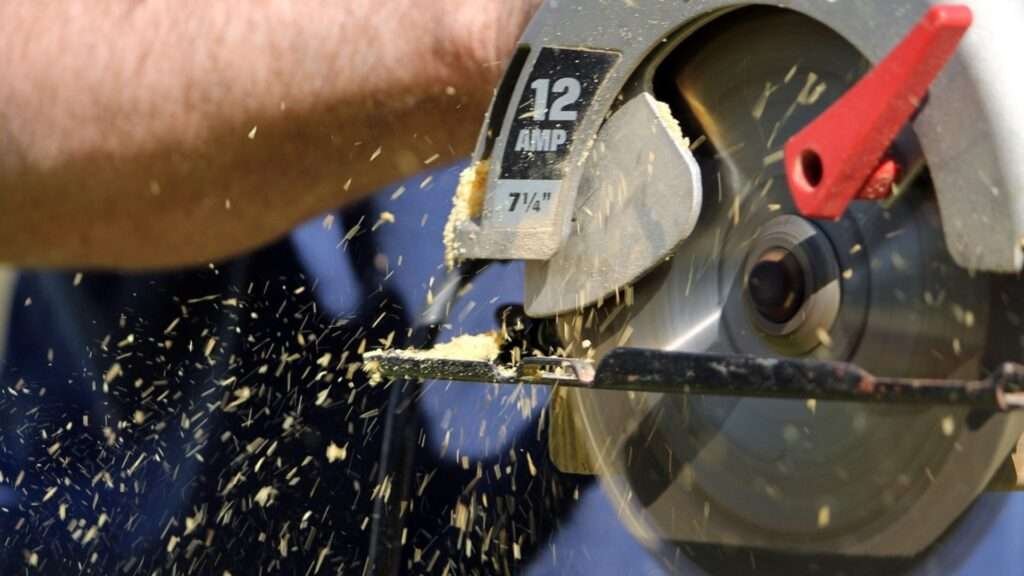Woodworking with Circular Saws and Routers
Circular
saws and routers are indispensable tools in the realm of woodworking, serving as
the backbone for a variety of intricate and fundamental tasks.
Their
significance spans across both amateur enthusiasts and seasoned professionals,
marking them as essential components in any woodworker’s toolkit.
Understanding
the basic functions and applications of these tools is crucial for anyone
looking to delve into the art and science of woodworking.
A
circular saw is a power tool that utilizes a toothed or abrasive disc or blade
to cut different materials, primarily wood.
Its primary function is to make straight cuts, whether crosscuts or rip cuts, with exceptional precision and speed.
Circular saws are known for their versatility, enabling woodworkers to perform a wide range of tasks from framing buildings to crafting fine furniture.
The recent advancements
in battery-powered circular saws have further enhanced their portability and
convenience, making them even more accessible for on-site work.
Routers,
on the other hand, are specialized tools used for hollowing out (routing) an
area in the face of a relatively hard workpiece, typically wood.
They are
essential for tasks requiring detailed and decorative cuts, such as creating
intricate edges, grooves, and profiles. Routers are also invaluable in joinery,
assisting in the creation of dovetails, mortises, and tenons.
With the
advent of electric and battery-powered routers, woodworkers now enjoy greater
freedom and flexibility in their projects.
The
evolution from traditional to modern woodworking tools, especially with the
integration of battery-powered innovations, has significantly transformed the
industry. Circular saws and routers have not only increased efficiency but also
expanded the creative possibilities for woodworkers.
Whether
you are crafting a simple shelf or an elaborate piece of furniture, these tools
are fundamental to achieving professional-quality results.
The
Origins and Early History of Circular Saws and Routers
The
history of woodworking tools is rich and multifaceted, with circular saws and
routers standing out as pivotal innovations.
The
journey begins in ancient times, with rudimentary tools that laid the
groundwork for more complex devices.
Early
woodworkers relied on manual saws and chisels, which, while effective, demanded
significant labor and skill.
The
evolution from these basic tools to the circular saws and routers we know today
marks a significant leap in woodworking efficiency and precision.
The
circular saw’s inception can be traced back to the late 18th century. Samuel
Miller is often credited with patenting the first circular saw blade in 1777 in
England.
However,
it’s essential to note that circular saw-like tools were reportedly in use even
earlier in Holland.
These
early iterations were primarily used in sawmills, where they significantly
boosted productivity by allowing continuous cutting, unlike the back-and-forth
motion of traditional saws.
The
introduction of steam power further propelled the circular saw’s popularity,
making it a staple in the industrial revolution’s woodworking sector.
Routers,
on the other hand, have a more intricate origin story. Initially, the term
‘router’ described a hand tool known as the “old woman’s tooth,” which was used
to hollow out areas of wood.
The
modern plunge router, however, emerged in the early 20th century. Patented by
George Kelley and John S. Borthwick in 1906, this electric-powered version of
the router revolutionized woodworking by adding a level of versatility and
precision previously unattainable with hand tools.
Its
ability to create intricate designs, dovetails, and joinery made it
indispensable for cabinetmakers and furniture craftsmen.
Both
circular saws and routers have undergone significant transformations, evolving
from manual, labor-intensive tools to sophisticated, electric-powered devices.
Their
historical development underscores their essential role in modern woodworking,
providing the foundation for the battery-powered innovations that continue to
push the boundaries of what’s possible in the craft.
The
Evolution of Electric Circular Saws and Routers
The
history of woodworking tools has been significantly shaped by the advent of
electric circular saws and routers, marking a monumental shift from manual to
power-assisted operations.
The
introduction of electric motors into circular saws and routers revolutionized
woodworking by enhancing both efficiency and precision.
Early
electric circular saws, which emerged in the early 20th century, were powered
by basic electric motors that allowed woodworkers to cut through materials with
unprecedented speed and accuracy.
This
innovation dramatically reduced the physical effort required, enabling
craftsmen to focus more on the finesse of their work.
As
technology progressed, so did the capabilities of these electric tools.
The development of more powerful and reliable electric motors facilitated the production of circular saws and routers with increased torque and cutting power.
This meant that even the most resilient hardwoods could be handled with relative ease. Additionally, the advent of variable speed controls allowed for greater versatility and precision.
Woodworkers
could adjust the speed of their tools to suit different materials and cutting
requirements, resulting in cleaner, more accurate cuts.
An
equally important advancement was the improvement in safety features. Early
electric saws and routers often lacked adequate safety mechanisms, posing
significant risks to users.
Modern
versions, however, come equipped with features such as automatic shut-off,
blade guards, and electronic brakes, which have greatly minimized the risk of
accidents and injuries.
These
safety enhancements have made electric circular saws and routers not only more
efficient but also more user-friendly.
Moreover,
the integration of advanced materials and ergonomic designs has further
revolutionized these tools.
Lightweight
yet durable materials have made electric circular saws and routers easier to
handle, reducing user fatigue during extended use.
Ergonomic designs ensure a comfortable grip, enhancing control and precision.
These
continuous improvements in design and technology have solidified the essential
role of electric circular saws and routers in modern woodworking, making them
indispensable tools for both amateur and professional woodworkers.
The Rise
of Battery-Powered Circular Saws and Routers
The
evolution of woodworking tools has seen a significant shift with the advent of
battery-powered circular saws and routers.
Historically,
these tools were primarily corded, tethering craftsmen to power outlets and
limiting their mobility.
This
dependency on cords often resulted in cumbersome setups and restricted
movement, hindering efficiency and adaptability on job sites.
The
transition from corded to cordless tools marked a pivotal moment in
woodworking. The initial foray into battery-powered tools faced challenges,
including limited battery life and insufficient power output.
However,
advancements in battery technology have since revolutionized the industry.
Modern lithium-ion batteries now offer extended run times and robust power,
comparable to their corded counterparts.
This
technological leap has facilitated the widespread adoption of battery-powered
circular saws and routers.
Battery-powered
circular saws and routers have substantially impacted the woodworking landscape
by enhancing mobility and convenience.
Woodworkers
can now operate in remote locations without immediate access to electrical
outlets, significantly broadening the scope of their projects.
The
absence of cords also reduces workplace hazards, such as tripping over cables,
thereby improving safety and workflow efficiency.
Innovations
in battery technology continue to push the boundaries of what cordless tools
can achieve.
Rapid
charging capabilities, increased battery capacities, and energy-efficient
designs are just a few examples of how these advancements are empowering
woodworkers to undertake more demanding projects with greater ease.
This
shift towards cordless tools underscores a broader trend in the industry
towards flexibility and user-centric designs.
The rise
of battery-powered circular saws and routers represents a confluence of
technological innovation and practical utility.
As
battery technology continues to evolve (I’m looking forward to solid state
batteries), it is poised to further transform the woodworking field, offering
enhanced performance and unparalleled convenience.
This
evolution not only benefits professional craftsmen but also hobbyists who seek
efficient, portable, and powerful tools for their woodworking endeavors.
The
evolution of circular saws and routers has significantly transformed
woodworking techniques, introducing a new era of efficiency and precision.
Traditionally,
woodworking relied heavily on manual tools, which were time-consuming and
required a high level of skill.
However,
the advent of circular saws and routers has dramatically changed this
landscape, making complex tasks more accessible and less labor-intensive.
Enhanced
Precision and Speed
One of
the most notable impacts of circular saws and routers is the enhancement in
precision and speed.
Circular
saws, with their high-speed rotating blades, allow for clean, straight cuts in
a fraction of the time it would take with a hand saw.
This
efficiency is particularly beneficial in tasks such as cutting large sheets of
plywood or making repeated cuts with consistent accuracy.
Similarly,
routers have revolutionized edge profiling, grooving, and joinery.
The ability to create intricate designs and joints with a router not only saves time but also ensures a level of precision that is difficult to achieve with manual tools.
Versatility
in Applications
The
versatility of circular saws and routers has also expanded the range of
woodworking projects that can be undertaken.
Circular
saws are not limited to straight cuts; with the right blade and technique, they
can make bevel cuts, dado cuts, and even plunge cuts.
This
flexibility allows woodworkers to tackle a variety of tasks with a single tool.
Routers, on the other hand, are indispensable for tasks such as mortising,
inlay work, and cabinetry.
The
ability to use different bits and attachments further extends their
functionality, making them essential for both basic and advanced woodworking
projects.
Improved
Safety and Ergonomics
Safety
and ergonomics have also seen significant improvements with the use of modern
circular saws and routers.
Ergonomically
designed handles and safety features such as blade guards and electronic brakes
reduce the risk of accidents and make the tools more comfortable to use for
extended periods.
Battery-powered
models have further enhanced safety by eliminating the hazards associated with
power cords, offering greater mobility and convenience.
In
summary, the transformative impact of circular saws and routers on woodworking
cannot be overstated.
These
tools have made woodworking more efficient, precise, and versatile, opening up
new possibilities for both amateur and professional woodworkers.
The
continuous advancements in their design and functionality ensure that they will
remain indispensable in the field of woodworking for years to come.
Electric
vs. Battery-Powered Circular Saws: Advantages and Considerations
In the realm of woodworking, the choice between electric and battery-powered circular saws is a pivotal one, influenced by various factors including power, endurance, mobility and convenience.
Understanding
the advantages & considerations of each type can help woodworkers make
informed decisions tailored to their specific needs and projects.
Electric
circular saws are renowned for their consistent power and endurance. Powered by
a direct connection to an electrical outlet, these saws deliver a steady
performance, making them ideal for heavy-duty tasks and extended use.
The
uninterrupted power supply ensures that electric saws can handle dense
materials and prolonged cutting sessions without the risk of power depletion.
This
makes them a preferred choice for professionals engaged in large-scale
woodworking projects where reliability and sustained power are crucial.
On the
other hand, battery-powered circular saws offer unparalleled mobility and
convenience.
Free from
the constraints of power cords, these saws allow for greater maneuverability,
making them suitable for jobs that require movement across different locations
or in environments with limited access to electrical outlets.
Advances
in battery technology have significantly improved the performance and battery
life of these saws, enabling them to tackle a wide range of tasks with minimal
downtime.
However,
despite these improvements, battery life remains a consideration, especially
for intensive cutting operations, where multiple batteries may be required to
ensure uninterrupted work.
When
choosing between electric and battery-powered circular saws, it is essential to
weigh the specific demands of the task at hand.
For
stationary workstations or projects requiring sustained power, an electric
circular saw may be more advantageous.
Conversely,
for on-the-go tasks or jobs in remote locations, the flexibility of a
battery-powered saw is invaluable.
Ultimately,
the decision should reflect the balance between the need for power endurance
and the convenience of mobility, aligning with the unique requirements of each
woodworking endeavor.
Versatility
and Mobility Advancements.
In the
realm of woodworking, routers stand as indispensable tools, crucial for
creating precise edges, intricate patterns, and flawless finishes.
The evolution of routers has seen significant advancements, particularly in the shift from traditional electric models to modern battery-powered variants.
Each
type brings its own set of features and advantages, tailored to different
woodworking needs and environments.
Electric
routers have long been the cornerstone of woodworking shops, offering
consistent power and reliability.
These
routers are typically favored for heavy-duty tasks where sustained performance
is paramount.
Their
direct connection to a power source ensures that there is no drop in
performance, making them ideal for prolonged use.
Additionally,
electric routers often come with more powerful motors, allowing them to handle
dense hardwoods and thick materials with ease.
This
makes them a preferred choice for professional woodworkers who require robust
and durable equipment for their projects.
On the
other hand, the advent of battery-powered routers has revolutionized the
woodworking landscape by introducing unprecedented mobility and convenience.
These cordless
routers are particularly beneficial for on-site work where access to power
outlets may be limited.
The
advancements in battery technology have significantly improved their runtime
and power output, allowing them to perform a wide range of tasks previously
reserved for their corded counterparts.
Modern
battery-powered routers are equipped with brushless motors, which not only
enhance efficiency but also extend the tool’s lifespan.
The versatility of battery-powered routers is further amplified by their lightweight and ergonomic designs, making them easier to handle and maneuver.
This is especially advantageous for intricate work or projects that require frequent repositioning. Moreover, many battery-powered models feature interchangeable batteries with other tools from the same manufacturer, offering added flexibility and reducing downtime.
Despite
the initial higher cost, the convenience and adaptability of battery-powered
routers make them a valuable addition to any woodworker’s arsenal.
In conclusion, the choice between electric and battery-powered routers depends largely on the specific requirements of the woodworking task at hand.
Electric
routers provide unmatched power and consistency for intensive applications,
while battery-powered routers offer exceptional mobility and convenience for
versatile and on-the-go projects.
Both
types continue to evolve, pushing the boundaries of what is possible in modern
woodworking.
The Role
of Circular Saws and Routers in Modern Woodworking.
With modern woodworking, circular saws and routers have become
indispensable tools, revolutionizing the craft with their versatility,
precision & efficiency.
These
tools have significantly transformed traditional woodworking practices, enabling
craftsmen to achieve higher levels of accuracy and productivity.
The
modern circular saw, with its ability to perform a wide range of cuts, has
evolved from a basic cutting tool into a sophisticated piece of equipment
essential for any woodworking project.
Whether
for making straight cuts, bevel cuts, or crosscuts, the circular saw’s
adaptability makes it a fundamental component of both amateur and professional
workshops.
Similarly,
routers have redefined the possibilities in woodworking by offering unparalleled
precision in shaping and detailing wood.
With
innovations such as variable speed control and interchangeable bits, routers
provide craftsmen with the ability to create intricate designs and smooth edges
that were previously unattainable with traditional tools.
The
router’s role in creating joints, hollowing out areas, and adding decorative
touches underscores its versatility and critical importance in modern
woodworking.
The
transition from corded to battery-powered circular saws and routers has further
cemented their role in the industry.
Battery-powered
innovations offer greater mobility and ease of use, allowing woodworkers to
perform tasks in various locations without being tethered to a lead.
This
advancement not only enhances efficiency but also opens up new possibilities
for on-site woodworking projects, making these tools even more valuable.
In
summary, the continuous evolution of circular saws and routers has brought
about transformative changes in the woodworking industry.
Their
essential role in enhancing precision, efficiency, and versatility underscores
their importance in modern woodcraft.
As
technology advances, these tools will undoubtedly continue to play a pivotal
role in shaping the future of woodworking, ensuring that craftsmen can push the
boundaries of creativity and craftsmanship.
What are Woodworking Circular Saws?
The term “circular saw” is most frequently used in the context of woodworking to describe a hand-held, electric or battery powered circular saw made specifically for cutting wood.
However, with a little effort, you can change the blade types to cut other materials. The side of the blade where the motor is located determines whether a circular saw is left- or right-handed.
18v Battery powered Circular Saw 165mm.
The Makita 18 volt cordless circular saw includes an inclination adjustment range of up to 50 degrees and two charge status indicators.
It includes an 18-volt lithium-ion battery and can be used in a wide variety of applications.
20v Battery powered Circular Saw 165mm.
The Dewalt 20v cordless circular saw is both powerful and efficient, with a brushless motor that provides optimal cutting performance in a wide range of materials.
It is easily steered or directed due to its lightweight and compact design.
The tool-free bevel lever allows you to quickly adjust the bevel capacity from 0 to 50 degrees.
For easy storage on the jobsite, it has a built-in rafter hook. Additional safety measures include an electromagnetic brake that stops the blade instantly when the trigger is released.
20v 2000mAh Battery powered Circular Saw 165mm.
The Extol 20v brushless circular saw is appropriate for almost any Woodworker.
It is powered by a cutting-edge brushless motor that operates at 3650 rpm, allowing users to cut hard materials quickly and easily while also extending tool life.
It is a strong motor that uses less energy than standard carbon brush motors.
In the event of a fall, the metal protective cover on top and bottom provides excellent blade protection.
The soft rubber grip is ergonomically designed to provide exceptional comfort and balance for easy-to-use cuts.
Automatic speed control, simple angle and depth adjustments, and a large base with guide rails are among the user-friendly features.
300mm Mitre Saw, 15amp, Single Bevel.
Dewalt 12inch Mitre Saws are a popular power tool.
They have a mitre detent plate made of stainless steel as well as a 300mm mitre saw blade with 14 positive stops.
They come with a precise mitre mechanism and a machined base fence support.
The tall sliding gate holds the 5 1/2-inch base vertically.
Bevel angles ranging from 0 to 48 degrees to the left and 0 to 3 degrees to the right. They are around 15 inches in height.
312mm Professional Sliding Mitre Saw.
The Bosch Mitre Saw comes with a new and improved dust control system that keeps the workplace clean and healthy.
Its 312 mm horizontal cutting capacity makes it suitable for a wide range of applications.
It is actually quite light, weighing only 17 kg, and thus allows for maximum mobility.
The integrated laser for precise sawing and integrated side material pull-outs are two of the most notable features.
10 inch 1800w Contractors Table Saw.
The Sherwood table saw, in particular, is one of the most attractive and efficient machines available. This is well worth the effort and merits closer examination.
It has a left tilting bevel for safer bevel ripping, a smooth and comfortable cast-iron rack and pinion height adjustment, and a long-lasting 70 mm high alloy fence that locks parallel to the blade at both ends of the table.
With 760 mm to the right and 330 mm to the left of the blade fence, rip capacity is maximized. An ultra-rigid pressed and folded steel stand houses a multi-directional movable wheel set.
What is a Woodworking Router?
The router is a must-have power tool for woodworkers, with a flat base and a rotating blade that extends past the base.
Typically, the spindles are powered by an electric or battery-powered motor and they spin at very high speeds.
Routers are used to rout/cut out a hollow area of your job and are capable of cutting a wide variety of patterns, grooves, and designs across multiple pieces of wood. Routers are classified into two types: fixed and plunge.
The base or sole of a plunge-base router is placed on the surface of the wood with the cutting bit raised above the work and then the cutter is lowered/plunged into the wood. The router bit position is constant with a fixed base router.
Variable Speed Woodworking Plunge Router Kit 15amp.
The WEN Plunge Router Kit includes a Router with a variable speed soft start 15a powerful motor capable of speeds ranging from 8,000 to 23, 000 RPM.
Because the plunger base locks in the downward position, it can be used as a fixed Router as well as a Plunge Router.
It accepts 1/4-inch and 1/2-inch Router bits and has a maximum plunge depth of 2-3/8 inches. Precision is provided by a 7-stop turret as well as macro and micro-adjustment knobs.
The sturdy carry case includes a multi-function straight edge fence, a template guide, a circle cutting cantering pin, a fence scale, and a 1-1/2 inch dust collecting duct.
2-1/4hp Variable Speed Combination Woodwork Router Kit.
The Bosch Plunge & Fixed Base Router combo features a 2-1/4 horsepower motor, electronic variable speed plunge, soft start, micro-fine depth settings, and an 8,000 to 25,000 rpm range.
It includes a soft-grip plunge base handle, fixed base wooden handles, collet chucks, wrenches, a template guide adaptor, chip shields, and a carrying case. It weighs 19-1/2 pounds and includes plunge and permanent bases.
2-1/4hp Variable Speed D-Handle Woodwork Router.
The Dewalt D-handle Router has a powerful electronic variable speed engine that provides enough power to route smoothly on even the toughest hardwoods.
It has electronic variable speed control with full feedback for consistent speed under load in the 8,000 to 24,000 rpm range.
The Soft start feature reduces start-up torque for better control, and the D-handle includes a trigger switch with a lock-on feature.
The vertically adjustable micro-fine depth adjustment ring provides precise depth adjustments in 1/64-inch increments.
The tool-free steel motor cam lock allows for quick depth and base adjustments. Motor latches with solid locking and quick release for quick and easy motor pack removal for bit and base replacement.
Precision Bench-top Woodworking Router Table.
Kreg appears to have done a fantastic job with this full-size router table; it has all of the functionality we need in a portable package.
This table includes an anodized aluminium fence with independent sliding faces as well as a strong steel stand with vibration-dampening rubber feet.
The tabletop measures 406mm tall, is edge banded & has a reinforced top (406mmx610mm).
¼ inch Woodworking 15 piece Router Bit Set.
The Bosch heavy duty set of router bits and accessories is intended to simplify routing. Suitable for almost any routing task, these high-quality carbide tip bits have a precision ground finish and are designed for maximum cutting performance.
Woodworking Router Table and 2hp Router Kit, 10amp.
A SKIL 10 Amp Fixed Base Corded Router completes the SKIL Table.
The table has above-the-table adjustability, integrated bit storage, an aluminium mite gauge slot, a router clamp, a starting pin & two feather boards for precision routing.
From start to finish, the router’s
powerful 10 Amp, 2.0 HP motor ensures smooth and accurate routing. Soft start, speed control, and a live tool indicator are all standard features.
The tall 16-inch aluminium fence with adjustable feather boards spans 24 inches wide and is capable of handling large stock. It also has adjustable face plates and a guard.









[…] https://www.glzwoodw.biz/circular-saws-and-routers/ […]
[…] Circular Saws & Routers […]